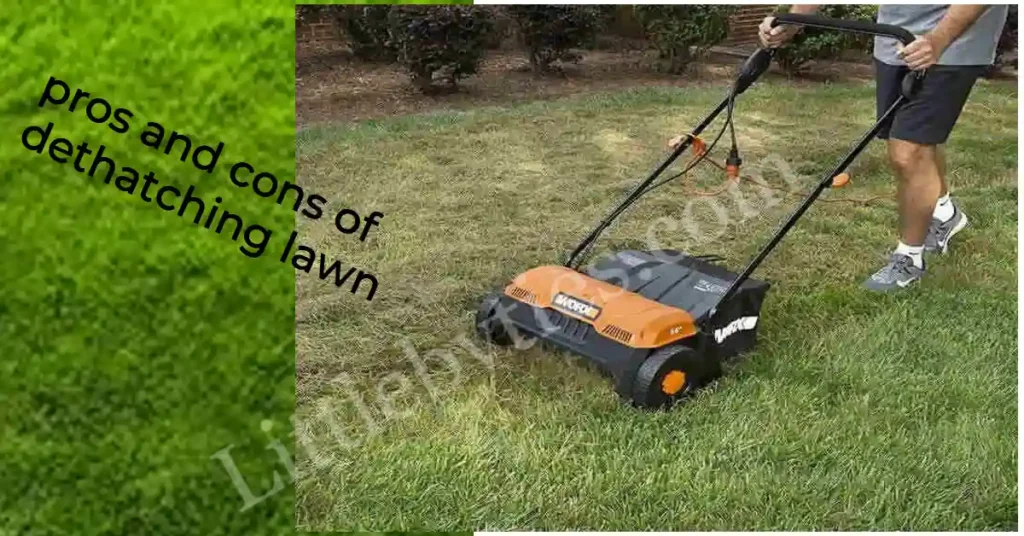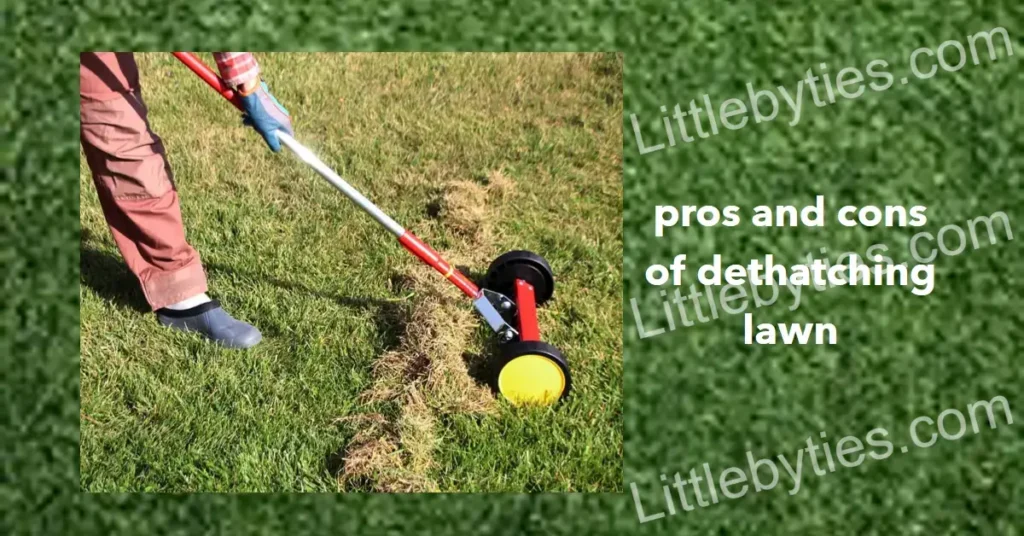Dethatching is like giving your lawn a deep clean. It involves removing a layer of dead grass and debris, known as thatch, from your lawn. This layer can stop water, air, and nutrients from reaching the soil and roots where they’re needed most. By using special tools, you can pull out this thatch, allowing your lawn to breathe and absorb all the good stuff it needs to stay healthy and look great.
What is Thatch and Dethatching?
Thatch
Thatch is a layer of dead grass, roots, and leaves that forms on the soil surface of your lawn. It’s like a tight mat sitting right on top of the ground.
Dethatching
Dethatching is the process of removing this layer. It’s done using tools that pull up the dead material, allowing water, air, and nutrients to reach the soil and roots more easily. Think of it as clearing out the old to make way for new growth.
Dethatching is vital for your lawn’s health. Too much thatch can suffocate your grass, making it hard for it to get what it needs to be lush and green. Removing thatch helps your lawn breathe, absorb more goodness from the soil, and stay healthy and beautiful. It’s a simple act that can mean a lot for your lawn’s look and health.
Pros of Dethatching Your Lawn
- Frees Up and Aerates the Soil: Dethatching removes the dense layer of dead material, allowing the soil underneath to breathe. This aeration encourages deeper and healthier root growth, leading to a more robust lawn.
- Provides Proper Nutrient Access for Your Turf: By removing thatch, you ensure that water, air, and nutrients can easily reach the soil and, consequently, the roots of your grass. This direct access helps your lawn absorb the essential nutrients it needs to thrive.
- Lessens Water Bills: A dethatched lawn absorbs water more efficiently. With improved water penetration, your lawn requires less watering, leading to lower water bills and more eco-friendly gardening.
- Enhances Fertilizer Absorption: After dethatching, fertilizers can penetrate the soil without getting trapped in the thatch layer. This means your lawn utilizes the fertilizer more effectively, leading to better growth and health.
- Reduces Fertilizer Expenses: With enhanced efficiency, you’ll need less fertilizer to maintain a healthy lawn. This not only saves you money but also reduces the environmental impact of excess fertilizer runoff.
- Improves Soil Health: Dethatching encourages a balanced soil ecosystem by removing the barrier that can harbor pests and diseases. A healthy soil promotes a healthy lawn with better resistance to stress and disease.
- Supports Lawn Seed Development and New Growth: Removing thatch provides a clear path for new seeds to reach the soil, ensuring better seed-to-soil contact and germination rates. This leads to denser grass and a more vibrant lawn.
- Helps Prevent Grass Diseases: A well-aerated lawn without excess thatch is less likely to develop fungal diseases, as it doesn’t trap moisture. This means a cleaner, healthier appearance and reduced need for disease control.
- Discourages Pests: Thatch can be a hiding place for many lawn pests. By dethatching, you disrupt their habitat, making your lawn less inviting to these unwanted guests.
- Increases the Aesthetics of Your Lawn: A dethatched lawn is not only healthier but also more attractive. It grows more evenly and has a lush, vibrant appearance that enhances your home’s curb appeal and your enjoyment of outdoor spaces.

Cons of Dethatching Your Lawn
- Needs More Water Initially: Right after dethatching, your lawn might need extra water. The soil is exposed and dries out faster, so you’ll need to keep an eye on it and water more often until the grass recovers.
- Dethatching Instruments Might Cause Damage: If not used carefully, dethatching tools can harm your lawn. They might pull up healthy grass along with the thatch or disturb the soil too much. It’s important to use them correctly to avoid damage.
- Makes the Soil More Accessible to Weed Seeds: Dethatching opens up the soil, which is great for your grass but also for weeds. With the thatch gone, weed seeds find it easier to settle and grow, which means you might have to deal with more weeds after dethatching.
- Makes Grasses More Vulnerable to Frost: Without the insulating layer of thatch, your grass might be more sensitive to cold and frost. This is especially important to consider if you’re dethatching close to the start or end of the growing season when frosts are more likely.
- Dethatching Can Eliminate Beneficial Bacteria: Just as it removes thatch, dethatching can also disturb the beneficial bacteria in the soil. These microbes are important for nutrient cycling and soil health, so disrupting them can have a negative impact on your lawn’s ecosystem.
- Dethatching Can Be Expensive: Hiring professionals or renting equipment for dethatching can add up. If you’re doing it yourself, buying the right tools can also be a significant investment. It’s worth considering the cost before deciding to dethatch.
- Dethatching Requires Time and Effort: It’s not just about the money; dethatching is also a labor-intensive process. It requires time, physical effort, and a bit of know-how to do it right. Make sure you’re prepared for the task before you start.
Best Practices for Dethatching Lawns
- Research on Equipment: Before you start, know what tools you need. Different lawns need different tools. Some might need a simple rake, while others might need a power dethatcher. Look up what’s best for your grass type and yard size. Choosing the right tool makes the job easier and protects your lawn.
- Preparation: Get your lawn ready before you dethatch. Mow it to a shorter length and mark any spots you want to avoid, like shallow irrigation lines or buried cables. Make sure the soil is moist but not soaked. This makes dethatching more effective and less stressful for your lawn.
- Testing: Try a small, hidden area first. See how the tool works and what the results are. This test run helps you adjust your technique before you tackle the whole lawn. It’s a good way to avoid mistakes and get a feel for the process.
- Professional Help: If you’re unsure or if your lawn is large, consider professional help. Pros have the right tools and know-how. They can do the job quickly and effectively, saving you time and effort. If the cost fits your budget, it’s often worth it for the expertise and ease.

How to Reduce Excessive Thatch Buildup
- Avoid Overwatering: Water your lawn just enough. Too much water keeps the soil wet and encourages thatch. Water deeply but less often. This helps roots grow deep and strong, reducing thatch buildup on top. Make sure your lawn gets a drink only when it needs one, usually when the top inch of soil is dry.
- Regular Aeration: Aerate your lawn every year or two. Aeration makes small holes in the soil. This lets air, water, and nutrients go deep into the ground. It breaks up compacted soil and thatch, letting your grass breathe and grow better. Aeration is like giving your lawn a quick refresh. It keeps the ground healthy and helps prevent too much thatch from forming.
Tips For a Lawn Dethatching Session
- Pick the Right Time: Dethatch your lawn when it’s growing and can recover quickly, usually in early spring or early fall. Avoid extreme heat or cold periods.
- Mow Shorter First: Before dethatching, mow your lawn to about half its normal height. This makes it easier to reach the thatch layer without stressing the grass too much.
- Water Beforehand: A day before dethatching, water your lawn. Moist soil makes the process smoother and protects the grass roots.
- Use Sharp Tools: Whether you’re using a manual rake or a power dethatcher, make sure the blades are sharp. Dull tools can pull up healthy grass and damage your lawn.
- Go Gentle: Don’t be too aggressive. Gently run the dethatcher over the lawn to lift the thatch without harming the soil or healthy grass.
- Clear the Thatch: After dethatching, rake up and remove the loosened thatch. This gives your lawn space to breathe and grow.
- Water and Feed: Once you’re done, water your lawn and consider applying a light fertilizer. This helps the grass recover and grow back stronger.
- Regular Maintenance: Keep an eye on thatch buildup and maintain your lawn regularly. Proper mowing, watering, and fertilizing go a long way in preventing excessive thatch.
Conclusion
In conclusion, dethatching is a crucial step in lawn care that removes harmful thatch, allowing your grass to breathe and absorb nutrients effectively. By choosing the right time, using the proper tools, and following a gentle approach, you can rejuvenate your lawn, ensuring it stays healthy and vibrant. Remember, a well-maintained lawn not only looks great but also enhances your outdoor space, making it a perfect spot for relaxation and enjoyment.
Shahid Maqsood is a distinguished copy writer and editor, boasting over a decade of expertise in the industry. As a prolific Content Writer and Editor, Shahid crafts daily articles on a wide array of subjects including books, business, news, and sports. He is an alumnus of Virtual University of Pakistan, holding an MBA, complemented by a Master’s in Mass Communications from the same institution. Residing in Faisalabad, Pakistan, his professional journey is marked by a commitment to excellence and integrity.
Shahid’s portfolio is a testament to his versatility and depth, with his work featured on multiple esteemed platforms such as dosttrusty.com, newsbreak.com, Quellpress.com, airriflehunting, bruitly.com, and the notable https://littlebyties.com/. Each article is a reflection of his insightful analysis, blending expertise, authoritativeness, and trustworthiness. His content not only engages but also informs a wide spectrum of readers, establishing Shahid as a trusted and reliable voice in the realm of digital content creation. With a passion that translates into every written word, Shahid Maqsood continues to enlighten and inspire with his professional, insightful, and engaging content.